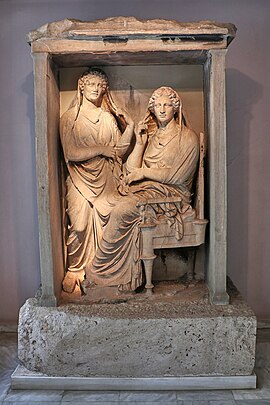Funerary naiskos of Demetria and Pamphile
| Funerary naiskos of Demetria and Pamphile | |
|---|---|
| Greek: Ναΐσκος Δημητρίας και Παμφίλης | |
 The stele in the KAMA | |
| Year | c. 320 BC |
| Catalogue | No P687 |
| Medium | Marble |
| Movement | Classical |
| Subject | Demetria and Pamphile |
| Condition | Intact |
| Location | Kerameikos Archaeological Museum, Athens |
The Funerary naiskos of Demetria and Pamphile (Greek: Επιτύμβιος ναΐσκος Δημητρίας και Παμφίλης) is a tomb memorial in honour of two deceased women named Demetria and Pamphile, erected in Athens in around 320 BC, shortly after Pamphile's death. It is made of marble and now kept at the Kerameikos Archaeological Museum in Athens, Greece, with inventory number P687, while a copy of it is found on the ancient site of the tomb.
History
[edit]The grave naiskos ("small temple") is one of last tombstone steles erected in Kerameikos, the cemetery of classical Athens, before the issuance of the prohibitory decree by the governor Demetrius of Phalerum in 317 BC regarding the adornation of tombs;[1] this naiskos is dated back to 320 BC. The relief bears the inscription "Demetria and Pamphile", the names of the two women depicted.[2] This is the second funerary stele of this family, as a earlier one has also been discovered, which was produced for Demetria when she died, some twenty years before Pamphile.[1]
The naiskos was discovered in 1870 at the western end of the south road,[3] and remained in situ until around April 2003, where it was transferred to the Kerameikos Archaeological Museum in order to be protected from corrosion and natural wear. A plaster cast was put in its place.[1]
Description
[edit]It was made of marble, and it is a typical example of the evolution of the naiskoi in the fourth century BC, as over time they became sunken into the relief, and the figures in high relief, almost entirely dettached from the surface.[1]

The naiskos shows two women, one sitting on a luxurious chair, while the other stands still beside her. The sitting woman is the recently deceased one, Pamphile, while the standing one is her sister Demetria, who had predeceased her.[2] Both women are dressed richly with long chitons and himatia that cover their heads,[3] starring blankly at the viewer now that they are both dead.[4] Both women have one arm resting on their abdomens, while with the other hand holding onto their himatia that cover their heads. Their clothes form elegant folds on their bodies, particularly visible with Pamphile's left leg, which is slightly stretched. Both women keep their hair done in elaborate tresses according to the customs of their era.
In Demetria's stele it is Demetria who is sitting, while the living Pamphile stands next to her. The two sisters are tenderly holding hands (dexiosis), symbolizing the deceased woman's departure as she bids farewell to her living sister.[2][1] This element is not present in the newer naiskos, as both sisters are now dead, and neither has to say goodbye. The heads of the older naiskos, now kept in the Archaeological Museum of Athens, are not preserved.[2]
See also
[edit]References
[edit]- ^ a b c d e "Η Επιτύμβια Στήλη της Παμφίλης και της Δημητρίας - Κεραμεικος" [The Grave Stele of Pamphile and Demetria - Kerameikos]. photodentro.edu.gr (in Greek). Retrieved December 18, 2023.
- ^ a b c d Banou 2014, p. 240.
- ^ a b Banou 2014, p. 241.
- ^ Banou 2014, p. 316.
Bibliography
[edit]- Banou, Eleni S. (2014). Kerameikos (PDF). Athens: John S. Latsis foundation. ISBN 978-960-98364-8-7.
External links
[edit] Media related to Naiskos of Demetria and Pamphile at Wikimedia Commons
Media related to Naiskos of Demetria and Pamphile at Wikimedia Commons
